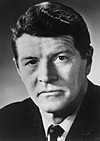 Born
in Monessen, Pennsylvania, March 26, 1916 Dr. Anfinsen obtained a B.A. degree
from Swarthmore College in 1937 and an M.S. in organic chemistry in 1939 from
the University of Pennsylvania. He spent the year 1939-40 as a Visiting Investigator
at the Carlsberg Laboratory in Copenhagen. In 1943, he received a Ph.D. from
Harvard Medical School in biochemistry and spent the next seven years at Harvard
Medical School; first as Instructor and then as Assistant Professor of Biological
Chemistry. During this time, he spent a year (1947-48) as a Senior Fellow of
the American Cancer Society working with Dr. Hugo Theorell at the Medical Nobel
Institute. Dr. Anfinsen left Harvard in 1950 to become Chief of the Laboratory
of Cellular Physiology and Metabolism in the National Heart Institute of the
National Institutes of Health. He was again at Harvard Medical School as Professor
of Biological Chemistry in 1962-63 and then returned to the National Institutes
of Health to assume his present position.
Born
in Monessen, Pennsylvania, March 26, 1916 Dr. Anfinsen obtained a B.A. degree
from Swarthmore College in 1937 and an M.S. in organic chemistry in 1939 from
the University of Pennsylvania. He spent the year 1939-40 as a Visiting Investigator
at the Carlsberg Laboratory in Copenhagen. In 1943, he received a Ph.D. from
Harvard Medical School in biochemistry and spent the next seven years at Harvard
Medical School; first as Instructor and then as Assistant Professor of Biological
Chemistry. During this time, he spent a year (1947-48) as a Senior Fellow of
the American Cancer Society working with Dr. Hugo Theorell at the Medical Nobel
Institute. Dr. Anfinsen left Harvard in 1950 to become Chief of the Laboratory
of Cellular Physiology and Metabolism in the National Heart Institute of the
National Institutes of Health. He was again at Harvard Medical School as Professor
of Biological Chemistry in 1962-63 and then returned to the National Institutes
of Health to assume his present position.In Anfinsen's early work, he and Steinberg studied the non-uniform labelling in newly synthesized proteins - a technique which later permitted Dintzis, Canfield and others to determine that proteins are synthesized sequentially from the amino-terminal and in vivo, and to calculate the rate at which amino acids are polymerized.
In the mid 1950's Anfinsen began to concentrate on the problem of the relationship between structure and function in enzymes. On the basis of studies on ribonuclease with Sela and White, he proposed that the information determining the tertiary structure of a protein resides in the chemistry of its amino acid sequence. Investigations on reversible denaturation of several proteins served to verify this proposal experimentally. It was demonstrated that, after cleavage of disulfide bonds and disruption of tertiary structure, many proteins could spontaneously refold to their native forms. This work resulted in general acceptance of the "thermodynamic hypothesis". Studies on the rate and extent of renaturation in vitro led to the discovery of a microsomal enzyme which catalyzes sulfhydryl-disulfide interchange and thereby accelerates, in vitro, the refolding of denatured proteins containing disulfide bonds. In the presence of this enzyme the rate of renaturation approaches that sufficient to account for folding of newly completed polypeptide chains during protein biosynthesis. These findings have given important impetus to studies on the organic synthesis of proteins, since they demonstrate that, under physiological conditions of environment, attainment of the native structure rests solely upon the correct sequential polymerization of the amino acids.
In addition to his research activities, Dr. Anfinsen xxx Biography Anfinsen Christian zoo - is xxx Anfinsen - Biography Christian zoo an editor of Advances in Protein Chemistry, served on the Editorial Board of the Journal of Biological Chemistry and wrote "The Molecular Basis of Evolution" which was published in 1959. He is active as a member of the Board of Governors of the Weizmann Institute of Science in Rehovot, Israel, and was elected President of the American Society of Biological Chemists for the Academic Year 1971-72. His honors include a Rockefeller Foundation Public Service Award in 1954, a Guggenheim Fellowship in 1958, election to the National Academy of Sciences in 1963 and the Royal Danish Academy in 1964, and Honorary Doctor of Science degrees from Swarthmore College (1965), Georgetown University (1967), and New York Medical College (1969).
In recent years, Anfinsen has devoted himself primarily to comprehensive investigations of an extracellular nuclease of Staphylococcus aureus. He and his colleagues have determined the sequence of its 149 amino acids and have described its fundamental enzymological, physical, and immunological properties. They have used an extensive range of spectroscopic and chemical techniques, including new methods of affinity labeling and cross-linking, to delineate the identity and relationship of amino acids in its active site. Dr. Anfinsen has collaborated closely with a crystallographic group at M.I.T., under Professor F.A. Cotton, which has determined the three-dimensional structure of nuclease at high resolution.